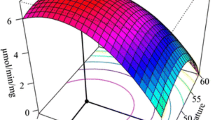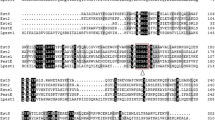Abstract
Cold-active enzymes have received little research attention although they are very useful in industries. Since the structure bases of cold adaptation of enzymes are still unclear, it is also very difficult to obtain cold-adapted enzymes for industrial applications using routine protein engineering methods. In this work, we employed directed evolution method to randomly mutate a mesophilic cellulase, endoglucanase III (EG III) from Trichoderma reesei, and obtained a cold adapted mutant, designated as w-3. DNA sequence analysis indicates that w-3 is a truncated form of native EG III with a deletion of 25 consecutive amino acids at C-terminus. Further examination of enzymatic kinetics and thermal stability shows that mutant w-3 has a higher Kcat value and becomes Fmore thermolabile than its parent. In addition, activation energies of w-3 and wild type EG III calculated from Arrhenius equation are 13.3 kJ · molt-1 and 26.2 kJ · molt-1, respectively. Therefore, the increased specific activity of w-3 at lower temperatures could result from increased Kcat value and decreased activation energy.
Similar content being viewed by others
References
Russell, N. J., Toward a molecular understanding of cold activity of enzymes from psychrophiles, Extremophiles, 2000, 4(2): 83–90.
Berchet, V., Thomas, T., Cavicchioli, R. et al., Structural analysis of the elongation factor G protein from the low-temperature-adapted bacterium Arthrobacter globiformis SI55, Extremophiles, 2000, 4(2): 123–130.
Russell, R. J., Gerike, U., Danson, M. J. et al., Structural adaptations of the cold-active citrate synthase from an Antarctic bacterium, Structure, 1998, 6(3): 351–361.
Schroder, L. H. K., Willassen, N. P., Smalas, A. O., Structural comparison of psychrophilic and mesophilic trypsins: Elucidating the molecular basis of cold-adaptation, Eur. J. Biochem., 2000, 267(4): 1039–1049.
Fields, P. A., Somero, G. N., Hot spots in cold adaptation: localized increases in conformational flexibility in lactate dehydrogenase A4 orthologs of Antarctic notothenioid fishes, Proc. Natl. Acad. Sci. USA, 1998, 95(19): 11476–11481.
Moore Jeffrey, C., Arnold, F. H., Directed evolution of a para-nitrobenzyl esterase for aqueous-organic solvents, Nature Biotechnol., 1996, 14: 458–467.
Johnston, J. R., Molecular Genetics of Yeast, Oxford: Oxford University Press, 1994.
Somogyi, M., Notes on sugar determination, J. Biol. Chem., 1952, 195: 19–23.
Sambrook, J., Fritsch, E. F., Maniatis, T., Molecular Cloning: A Laboratory Manual, 2nd ed., New York: Cold Spring Harbor Laboratory Press, 1989.
Zavodszky, P., Kardos, J., Petsko, G. A., Adjustment of conformational flexibility is a key event in the thermal adaptation of proteins, Proc. Natl. Acad. Sci. USA, 1998, 95(13): 7406–7411.
Feller, G., Gerday, C., Psychrophilic enzymes: molecular basis of cold adaptation, Cell Mol. Life Sci., 1997, 53(10): 830–841.
Miyazaki, K., Wintrode, P. L., Grayling, R. A. et al., Directed evolution study of temperature adaptation in a psychrophilic enzyme, J. Mol. Biol., 2000, 297(4): 1015–1026.
Taguchi, S., Ozaki, A., Momose, H., Engineering of a cold-adapted protease by sequential random mutagenesis and a screening system, Appl. Environ. Microbiol., 1998, 64(2): 492–495.
Author information
Authors and Affiliations
Corresponding author
Rights and permissions
About this article
Cite this article
Xiao, Z., Wang, P., Qu, Y. et al. Cold adaptation of a mesophilic cellulase, EG III from Trichoderma reesei, by directed evolution. Sci. China Ser. C.-Life Sci. 45, 337–343 (2002). https://doi.org/10.1360/02yc9037
Received:
Revised:
Issue Date:
DOI: https://doi.org/10.1360/02yc9037




